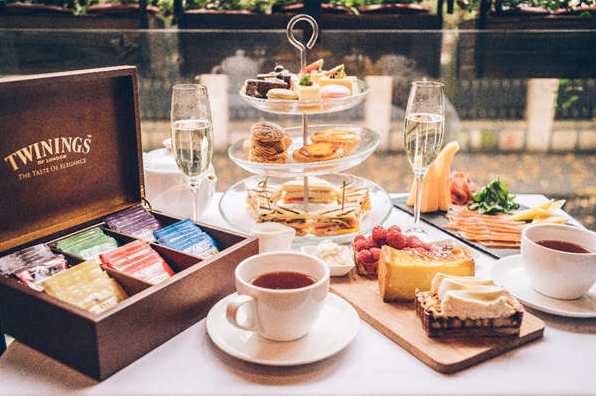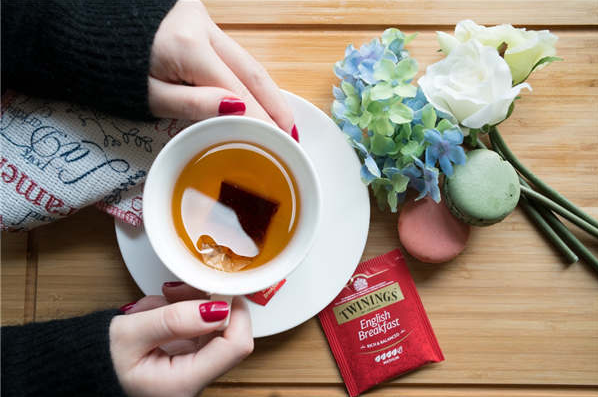A tea-scented spring breeze blows from Britain
When reading Pride and Prejudice, you can encounter many scenes with characters either brewing tea or chatting over a cup of tea in the drawing room.
It's a truth universally acknowledged that tea, the afternoon tea in particular, plays a crucial part in Britons' social life, much like what Jane Austen wrote in her many country-house comedies.
In this mild season with gentle spring breezes and pleasant sunshine, it seems like a good idea to while away the hours with friends over a refreshing brew on a beautiful March afternoon.
When it comes to tea drinking, unlike Chinese people, who emphasize sources and the original flavors of teas, Britons pay more attention to tea blending and the enjoyment brought by a cup of tea and some sweet treats. Therefore, blended tea is at the core of British tea culture.Therefore, blended tea is at the core of British tea culture.

A British afternoon tea ceremony with a gift box displaying different Twinings teas. [Photo provided to chinadaily.com.cn]
Blended tea came about for two main reasons. First, Britain, like other European countries, lacks the climate for growing tea. Thus, with a variety of quality tea imports from around the world, they blended teas of different origins in proportion, hoping to perfectly fuse the aromas of these teas. For instance, black teas originating from Assam and Ceylon are usually blended together for balance, as the former has a bold flavor and faint aroma while the latter has the complete opposite. Second, tea blends were created because they can better satisfy customers, who want steady flavors.
To serve a cup of tea with a flavor that endures over time, one needs outstanding tea blending techniques. Twinings, a celebrated British tea brand dating back to 1706, prides itself on having a host of master blenders and flavor experts to secure its vibrant and aromatic blends loved by all.
While holding fast to its over 300-year-long history of tea blending, Twinings has never ceased to push the envelope of tea blending techniques. The brand has created nearly 200 flavors of English tea thus far.

A serving of Twinings English Breakfast tea. [Photo provided to chinadaily.com.cn]
To blend and craft the best tea products in the world, Twinings master blenders have all spent over 20 years building their tasting experience in the industry.
After exploring and purchasing premium teas from around the globe, they guarantee the flavors and quality of tea blends by using their expertise in the geographical locations and climates of the world's tea plantations. In addition, flavors are tailored to the preference of different markets. But above all, in pursuit of customers' favorite cuppa, they have to select the most suitable teas from myriad choices to make these blends and keep tasting and adjusting.
Normally, a cup of tea both starts and ends a Briton's day, but different teas are consumed at different times.
Soon after you get up, make yourself a cup of English Breakfast Tea, a blend of Assam and Kenyan black teas. With a bold color and great mouthfeel, this refreshing tea flavored with milk can immediately revive you in the early morning hours.
When it's 11 o'clock in the morning, Britons of all stripes – from carefree nobles to the busy working class -- will take a rest and enjoy a cup of tea with some biscuits, which they call elevenses or "a tea or lunch break". For this cup, they generally prefer Darjeeling, known as "the Champagne of teas" for its pungent flavor and distinctive fruity fragrance. The 20-minute tea break can give workers another boost during the course of the day.
The elegant afternoon tea usually takes place around 4 pm. While traditional flavors like Earl Grey and Ceylon are fine choices, you can also try fruit and herbal teas as well as green teas. Furthermore, enjoying your afternoon tea along with some exquisite pastries can allow you to sit back and let your soul be carried away for a while.
The afternoon tea, the most renowned part of British tea culture, has become a dramatic symbol of the country. People today have neatly summed up the essence of English afternoon tea culture in this way: "Serve the best tea in the best chinaware in the best room and talk about the most intimate topics with your best friend."
Over time, afternoon tea has evolved to mean much more than mere delicacies. Since the 18th century, the entire British society -- from aristocrats to the working class -- has increasingly become captivated by afternoon tea parties. As time goes by, this fad has gradually grown into an important ritual in British social life.
In modern society, the social side of an afternoon tea party usually seems to matter more than the flavor of the tea itself. However, tea is always the absolute center of this occasion.
When the afternoon comes, whether you are busy or free, accompanied or alone, all you have to do is to have a brew and wind down by savoring the delight of your afternoon tea time.



 闽公网安备 35020302000788号
闽公网安备 35020302000788号